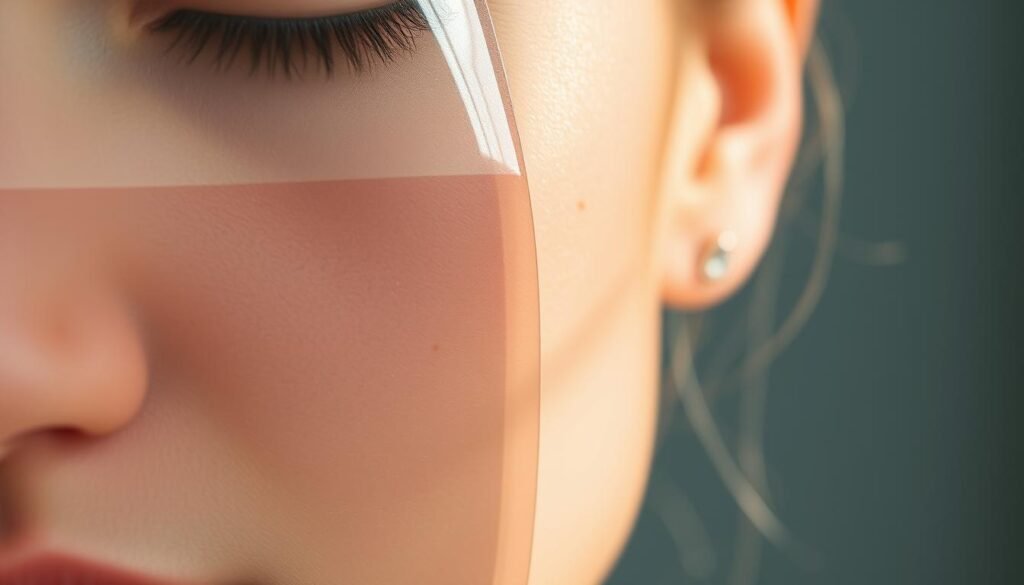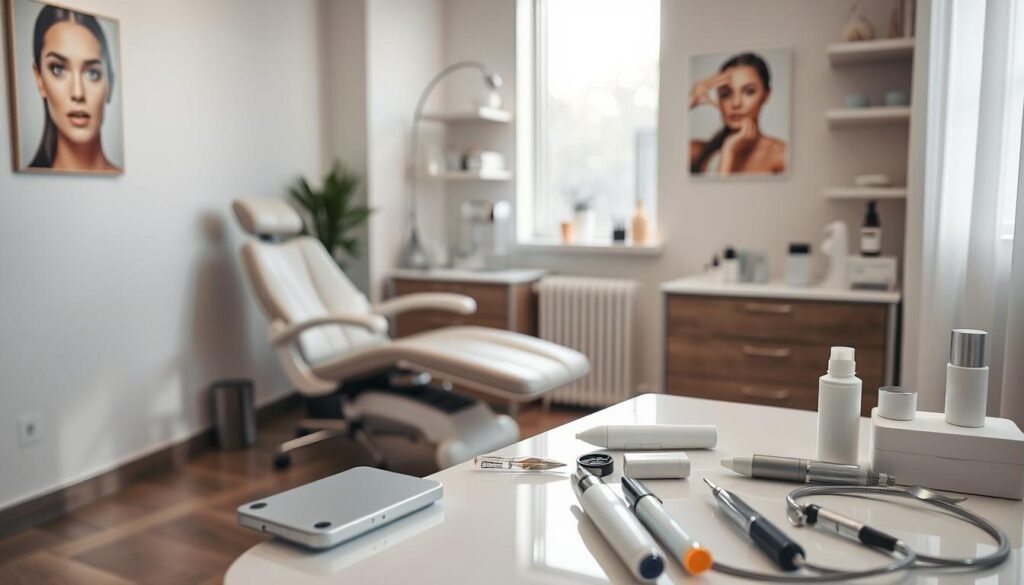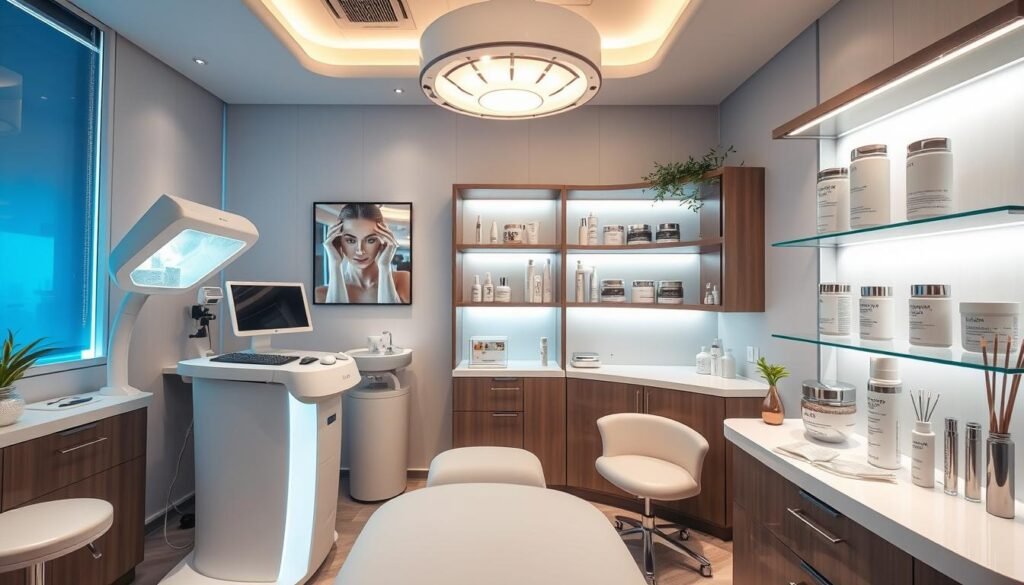Did you know that as many as 80% of young people aged 11-30 deal with acne? It often leaves scars behind. These scars can hurt how we feel about ourselves just as much as how they look. It’s key to know the different ways to treat scarring from severe acne. The success of treatments can vary based on what a person needs and the type of scars they have.
Many find success with a mix of doctor-recommended treatments and home care. This approach depends on their skin type and how bad the scarring is. Choosing the right acne scar treatment also considers skin tone, budget, and required sessions. Treating acne scars means more than just improving looks. It boosts self-confidence and how we interact with others, affecting even our job prospects.
Key Takeaways
- Acne scars are a concern for up to 50 million Americans every year.
- Creating a treatment plan that fits you is vital for the best care.
- There are many treatments to target different scar types.
- The way we feel about our scars can touch our self-worth and how we connect with people.
- Talking to a skin doctor helps find the top treatment choices.
- Oftentimes, health insurance won’t cover the cost for treating acne scars.
- Using more than one therapy may give the best chance at lessening scars.
Understanding Acne Scars
Acne scars can significantly affect how we look and feel. Knowing the different Types of Acne Scars helps us understand what causes these marks. It’s key to learn how Acne Scarring Occurs to find the right Acne Scar Treatments.
Types of Acne Scars
Different scars appear based on how severe the acne was. Here are the common ones:
- Ice Pick Scars: Deep, narrow marks like tiny punctures.
- Boxcar Scars: Wide, shallow pits that look like rectangle shapes.
- Rolling Scars: Uneven skin texture because of damage under the skin.
- Hypertrophic Scars: Thick, raised scars from too much collagen.
- Keloid Scars: Big, raised scars that grow bigger than the wound.
Scars can show up anywhere like on the face, back, chest, and shoulders. It’s important to note ice pick scars are most common. They make up about 60-70% of atrophic acne scars.
How Acne Scarring Occurs
Severe acne, especially cystic acne, often leads to scarring. Things that can make scars worse include:
- Picking or squeezing pimples.
- The body’s healing process that sometimes makes too much collagen.
- Genes that make some more likely to get scars.
Understanding Acne Scarring Occurs shows healing can be different for everyone. Therefore, Acne Scar Treatments must be chosen based on scar types and severity.
| Scar Type | Description | Commonality |
|---|---|---|
| Ice Pick | Deep, narrow indentations. | 60-70% |
| Boxcar | Wide depressions resembling rectangles. | Common |
| Rolling | Wavy texture beneath the skin’s surface. | Common |
| Hypertrophic | Elevated scars caused by excess collagen. | Less Common |
| Keloid | Thick, raised scars extending beyond the injury. | Less Common |
Learning about the different Types of Acne Scars and their formation is key. It helps us find the best treatments for those dealing with acne damage.
Why Treatment is Important
Treating acne scars is more than improving looks. It’s crucial for mental health too. Acne scars hurt Impact on Self-Esteem a lot. They make people feel bad about themselves.
Because of scars, many avoid hanging out or going on dates. They even miss out on job chances.
Impact on Self-Esteem
Acne scars can damage how people see themselves. About one-third with scars feel less confident. How we view ourselves affects our everyday life and choices.
People feel stuck because of their skin. Knowing how well treatments can work helps. It brings back confidence and happiness.
Social and Professional Limitations
Scars can stop people from going out. They worry others will judge them. This fear also affects jobs and moving up in careers.
First impressions are key in many situations. That’s why finding a good treatment matters. It opens the door for better social life and job success.

Home Remedies for Scarring from Severe Acne
There are different ways to tackle scarring from severe acne. This includes over-the-counter products and natural remedies. Using home remedies that have skin healing properties can be effective. It helps to know about both modern and natural treatments to have many options.
Effective Over-the-Counter Products
Choosing over-the-counter products means looking at their active ingredients. Ingredients like retinoids, salicylic acid, and azelaic acid are well-known for treating acne scars. Salicylic acid is especially good for reducing redness and dark spots.
A study in 2010 showed that using products with 30% salicylic acid every three to four weeks works well. Topical retinoids help new skin cells grow. They reduce dark scars and stop new acne. Products with lactic acid can also renew the skin and help with different scar types.
| Product Type | Active Ingredient | Benefits |
|---|---|---|
| Peeling Products | Salicylic Acid | Reduces swelling and discoloration |
| Topical Treatments | Retinoids | Blocks inflammation and accelerates cell regeneration |
| Exfoliating Agents | Lactic Acid | Increases skin cell renewal and reduces hyperpigmentation |
Natural Remedies
Adding natural remedies to your skincare can also help. Ingredients like black seed oil are great for healing wounds. Rosehip seed oil and honey are also good, making scars less visible when used regularly. Aloe vera is known for its ability to soothe skin and make scars smaller. These natural options can make your skin look and feel better.
Consulting a Dermatologist
Seeing a dermatologist is crucial if you’re dealing with acne scars. Experts know how skin conditions work. They offer advice perfect for your skin and scars. This makes finding the right treatment easier. With their help, you’ll know which treatments can best help you.
Importance of Professional Guidance
Acne hits over 80% of teens, often leaving scars. Dermatologists are trained to check how bad these scars are. They suggest treatments like peels, lasers, and injections to make skin look better. Getting their help ensures you get care that fits your needs. They also spot if hormones play a role in your acne.
What to Expect During a Consultation
Be ready to talk about your skin’s history, your budget, and what results you want. The dermatologist will look closely at your skin. They’ll consider things like hormones, diet, and lifestyle. Knowing all this, they can plan out the best treatment. Spending time on this chat is key to bettering your skin.

Acne Scar Removal Procedures
There are many ways to remove acne scars, suited for different scar types and individual needs. It’s important to know about these surgical techniques to choose wisely. These treatments can lessen scar visibility, improving skin confidence.
Overview of Surgical Techniques
There are several surgical techniques that help achieve smoother skin. They include:
- Punch Excision: This method involves removing scars and the hair follicle, then smoothing the area.
- Subcision: This releases scar tissue from deeper skin layers, making other treatments more effective.
- Dermabrasion: Sanding the skin helps improve shallow scars, especially boxcar and rolling types.
- Laser Treatments: Lasers take off the top skin layer and boost collagen. More than one session might be needed.
For more on acne scar treatments, visit this resource.
Factors to Consider Before Surgery
Before choosing a surgery, consider these factors for success:
| Factor | Consideration |
|---|---|
| Skin Type | Different procedures work best on certain skin types. |
| Scar Type | Some methods are better for specific scars like ice pick, boxcar, or rolling. |
| Budget | The cost varies widely between treatments. Plan according to your budget. |
| Recovery Time | Healing time differs for each person and procedure. Consider this carefully. |
Thinking about these factors will help you pick the right surgery for acne scars. It also sets realistic healing expectations.
Dermatologic Treatments for Acne Scars
There are many treatments for acne scars that really work. Knowing how they work helps people decide what’s best for their skin.
Chemical Peels
Chemical peels use acids to peel off damaged skin, helping new skin grow. This makes the skin smoother and scars less visible. People often need several treatments for deep scars.
Microdermabrasion
Microdermabrasion is a soft way to get smoother skin. It removes the top layer of skin cells. To keep skin looking smooth, you should get it done regularly.
Laser Resurfacing Options
Laser treatments, like ablative and fractional lasers, are great for acne scars. They focus on scars and help make new collagen. Combining lasers with other treatments gives better results.

Injectable Treatments for Acne Scars
Injectable treatments are a ray of hope for people with acne scars. They make the skin smoother and look better. This boosts confidence. For different types of scars, there are soft tissue fillers and steroid injections.
Soft Tissue Fillers
Soft tissue fillers lift the scars by adding volume under the skin. They use collagen, fat, and other materials. People have seen a 64% to 93% improvement, with some fillers achieving up to 96%.
The results last from 3 to 24 months. But, it’s vital to get injections from experts to avoid risks. Seeing a dermatologist can help pick the best option for you.
Steroid Injections
Steroid injections work well for raised scars. They make the scars flatter by reducing collagen. These injections give good results, especially with other treatments.
While these treatments have benefits, they also have risks like infections. Safe techniques and careful assessment are crucial for success.
| Type of Treatment | Material | Duration of Results | Satisfaction Rate |
|---|---|---|---|
| Soft Tissue Fillers | Collagen, Fat, Synthetic | 3-24 months | 64%-93% |
| Steroid Injections | Corticosteroids | Varies | High Satisfaction |
Energy-Based Treatments
In the world of scar healing, energy-based treatments for acne scars stand out. They’re safe and work well by using energy waves to boost collagen. This makes the skin smoother and scars less visible. Radiofrequency treatments are especially popular and have proven to do well in studies.
Radiofrequency Treatments
Radiofrequency treatments are great because they work for all skin types. A study of 40 people showed that about 75% saw their scars improve. They had around 1.7 sessions on average. These treatments have little to no downtime and very few side effects.
Patients were generally happy with their results. Best of all, there were no issues with changes in skin color. This makes radiofrequency treatments a top choice for scar reduction.
Ultrasound Therapy
Ultrasound therapy is another great choice for treating scars with energy. It’s similar to radiofrequency but doesn’t harm the top layer of skin. Studies show it’s good for reducing acne scars, especially certain types. Patients can expect quick healing, usually in just over two days.
They often return to their regular activities fast. For more details on how it works, check the full study here.